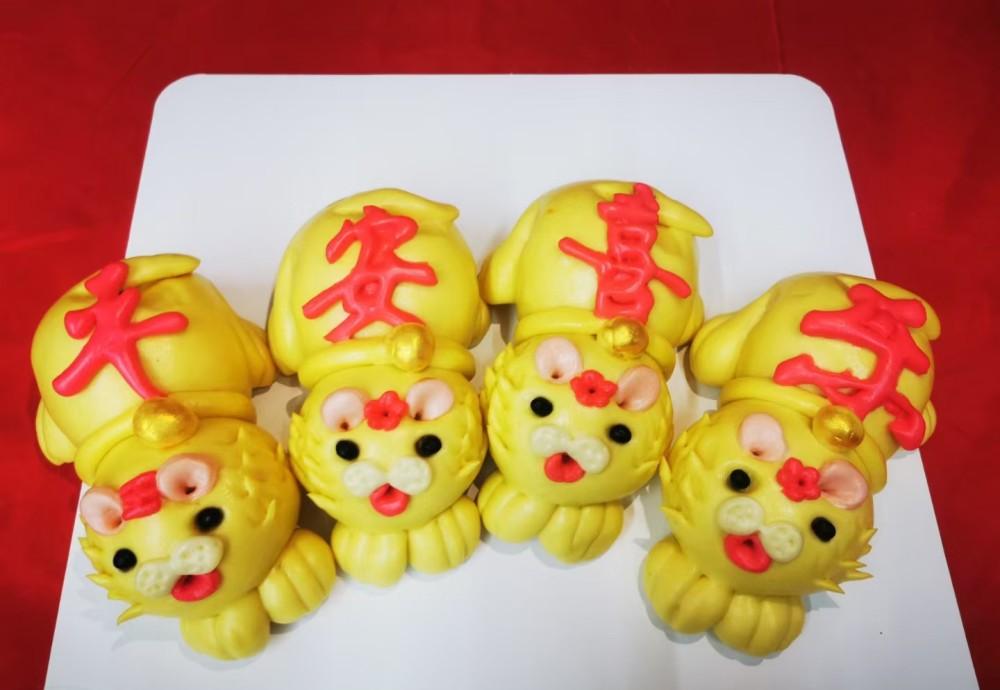"Just now I took two more orders, Urumqi wants 20 boxes, Hainan wants 50 boxes, tomorrow to rush out." On January 15th, during the weekend, Chi Jinyan, a non-hereditary inheritor of the flower dumpling making skills in Laixi City, was extremely busy, and she was making the tiger flower dumplings in her hand while taking orders to arrange the production plan.
Chi Jinyan said that after entering the Waxing Moon, the orders for flowers and food continued to flow, and she and the master in the store basically had to be busy until 10 p.m. every day, and there was no rest on weekends. "Our orders are available all over the country, and as the popularity of Hua Bao is getting higher and higher, our order volume is also rising, and this year it has increased by about 40%." Chi Jinyan said that at present, she has received nearly 10,000 orders from customers across the country.

Flower dumplings are also known as "flower buns", "face sculptures", "folk face flowers". In the Jiaodong region of Shandong, many important moments in the family are inseparable from flowers and flowers, sending "shou peaches" to the elderly to wish for their birthdays, and betrothing relatives to buy a pair of "Mandarin ducks". Especially during the New Year, every household will steam a large flower, which means that it is thriving and prosperous.
As early as 2009, Jiaodong Hua rao folk customs were included in the list of intangible cultural heritage of Shandong Province. As a branch of Jiaodong Flower Dumpling, Laixi Flower Dumpling Technique has been inherited and innovated by the Chi family of Jiangshan Three Villages in Jiangshan Town, Laixi City for more than 150 years and 5 generations, and the skills have been perfected day by day, and it has become one of the representatives of Flower Dumpling in Jiaodong Area.
As the fifth generation of the Chi family's inheritors, Chi Jinyan has had the dream of carrying forward this ancestral skill since she was a child. In 2016, Chi Jinyan gave up the high salary in the construction industry to return to her hometown and devote herself to the research and inheritance of this ancestral skill.
And noodles, waking up noodles, kneading dough, modeling, and in a short while, a vivid "golden tiger" flower feast was born in Chi Jinyan's hands.
"Don't think that the production of this small flower dumpling is very simple, in fact, from the selection of materials, grinding, making the introduction to the styling, waking up, coloring a total of 12 processes, which step is sloppy." Chi Jinyan said that the coloring pigments used in traditional flowers and flowers are good but cannot be eaten, and the production of small workshops cannot meet the market demand, and if you want to make the flowers into a large industry, you must be healthy, large-scale and standardized.
Therefore, Chi Jinyan registered and established a professional flower food company, and asked experts to study and improve the formula, using the best flour of the strong road and accompanied by raw materials such as mountain eggs and honey, so that people can "stick" to their mouths with one bite. In view of the problem that the coloring pigments used in traditional flowers and flowers are not good to eat, Chi Jinyan has innovated the use of spinach, dragon fruit, purple potatoes and other vegetable juices to make flowers, so that the flowers not only look pleasing to the eye but also eat more healthy and delicious.
"Old noodles" lead to fermentation, artificial kneading and dough flowers, steaming in large iron pots... While meticulously inheriting the craftsmanship and striving for excellence, Chi Jinyan boldly integrated fashion elements to strengthen styling innovation, and at the same time launched the "private customization" flower feast quickly opened up sales channels and was recognized by consumers.
With a love for flowers and the inheritance of old craftsmanship, in 2019, Chi Jinyan herself funded the creation of the first flower and food culture museum in Jiaodong. The museum covers an area of more than 1,000 square meters, with a collection of 368 physical objects, including production tools for wheat planting in different periods, steamed bun making tools, and historical materials on the culture of flowers and flowers.
"Spring sculpture phoenix play peony, summer plastic dragonfly dipped lotus, autumn sculpture butterfly love chrysanthemum, winter plastic magpie to ensure peace." Relying on her dexterous hands, Chi Jinyan passed down and carried forward the production skills of Jiaodong Hua Rao more than 300 years ago, and Hua Rao really made her find the value of her life. "Our cultural self-confidence is inseparable from the nourishment of traditional culture, and it is my lifelong pursuit to pass on the skills of flowers and flowers from generation to generation." Chi Jinyan said.
Hand made man said
Let the flower feeding skills be passed on from generation to generation
Chi Jinyan, the inheritor of The production skills of Laixi Flower Dumplings: Leaving the taste of flowers and flowers and passing it on to future generations is the most meaningful thing I have done, and I hope to drive more young people to join in, learn to make flowers and dumplings, and learn to get rich while learning a craft to get rich, and can more deeply understand the connotation of traditional culture.
Inheriting and revitalizing traditional handicrafts not only helps to carry forward the excellent traditional Chinese culture, but also cultivates the spirit of craftsmen. Therefore, in the next step, I plan to strengthen cooperation with the local vocational education center, train more professional technicians to strengthen the industrial strength, and let the flower and food skills be passed on from generation to generation.